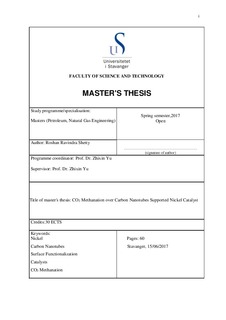| dc.contributor.advisor | Yu, Zhixin | |
| dc.contributor.author | Shetty, Roshan | |
| dc.date.accessioned | 2017-10-26T14:07:22Z | |
| dc.date.available | 2017-10-26T14:07:22Z | |
| dc.date.issued | 2017-06-15 | |
| dc.identifier.uri | http://hdl.handle.net/11250/2462449 | |
| dc.description | Master's thesis in Petroleum engineering | nb_NO |
| dc.description.abstract | CO2 hydrogenation to methane has become one of the most researched area due to the possibility of reducing CO2 emissions and at the same time to be utilized in the power-to-gas or biogas upgrading technology. Catalyst is the medium through which in terms of kinetic rates and selectivity, the efficient CO2 conversion is possible. This thesis deals with the development of nickel based catalysts supported on carbon nanotubes to evaluate their potential for CO2 methanation. Multiwalled carbon nanotubes (CNT) with three different inner-outer diameters (CNT1020, CNT2040 and CNT4060) were used as a support. One of the major focus was the surface functionalization of CNTs with oxygen and nitrogen groups to see the effect of surface doping on the catalyst performance for CO2 methanation.
Surface functionalization of the CNTs with oxygen was done by refluxing with nitric acid. And nitrogen doping was done by further post treatment with ammonia as nitrogen precursor. Nickel supported on original, oxidized and nitrogen doped CNT catalysts were prepared by incipient wetness impregnation.
Several characterization was performed to evaluate the physical and chemical properties of the catalysts. FTIR, Raman and TGA showed that modification by oxygen doping has successfully introduced Oxygen containing groups, while the Nitrogen doping is less successful. N2 physisorption study demonstrated obviously that CNTs with smaller diameter had higher surface areas, which further increased upon doping with oxygen. The XRD characterization showed close but small particle sizes for all the CNTs supported catalyst. TPR study also presented that the reduction behavior and reducibility of different catalysts were close. BET showed a slight increase in the impregnated catalysts than the CNTs due to better porous structure developed during calcination. H2 Chemisorption however, demonstrated that oxygen doped Ni catalyst had high dispersion, while the Nitrogen doped catalyst had the lowest dispersion.
The catalysts were tested for CO2 methanation at the same condition of 350 oC, 1 atm with a H2/CO2 ratio of 4 in a fixed bed reactor for 16 hr. It was found that the functionalized CNTs supported Ni catalysts had lower CO2 conversion and CH4 selectivity compared with the original CNTs supported catalysts, which was explained by lower CO2 and CH4 capacity after oxygen and nitrogen treatment. The CNT1020 supported nickel catalyst showed highest conversion of 43% and selectivity of 91% when compared to other CNTs supported Ni catalysts. | nb_NO |
| dc.language.iso | eng | nb_NO |
| dc.publisher | University of Stavanger, Norway | nb_NO |
| dc.relation.ispartofseries | Masteroppgave/UIS-TN-IPT/2017; | |
| dc.rights | Navngivelse 4.0 Internasjonal | * |
| dc.rights.uri | http://creativecommons.org/licenses/by/4.0/deed.no | * |
| dc.subject | petroleumsteknologi | nb_NO |
| dc.subject | petroleum engineering | nb_NO |
| dc.subject | produksjonsteknologi | nb_NO |
| dc.subject | nickel | nb_NO |
| dc.subject | carbon nanotubes | nb_NO |
| dc.subject | surface functionalization | nb_NO |
| dc.subject | catalysts | nb_NO |
| dc.subject | co2 methanation | nb_NO |
| dc.title | CO2 Methanation over Carbon Nanotubes Supported Nickel Catalyst | nb_NO |
| dc.type | Master thesis | nb_NO |
| dc.subject.nsi | VDP::Technology: 500::Rock and petroleum disciplines: 510::Petroleum engineering: 512 | nb_NO |

